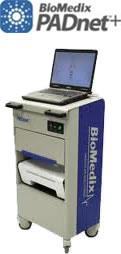Vascular Testing Using PADnet
People with Peripheral Artery Disease (PAD) are at significantly increased risk for stroke and heart attack. Take this brief test to determine if you are at risk for Peripheral Artery Disease and if a vascular exam will help us better assess your vascular health status.
Take the Peripheral Arterial Disease Test
What is PAD?
Peripheral arterial disease, known as PAD, is a common, yet serious disease that is extremely under diagnosed. PAD occurs when there is a buildup of cholesterol and plaque in the arteries of the lower extremities, causing decreased blood flow to the legs and feet. Just like build up in the heart, clogged arteries in the lower extremities can cause stroke or heart attack. Luckily, today there is a new, non-invasive technology that can detect if you are at risk.
Peripheral arterial disease is a serious circulatory condition where clogged or narrowed arteries cause poor circulation to the arms, legs, brain or kidneys. It occurs most often in the lower extremities, causing decreased blood flow to the legs and feet. Just like buildup in the heart, clogged arteries in the lower extremities can cause stroke or heart attack. Over 10 million Americans have PAD and, left untreated, PAD is fatal 30% of the time within a five-year period. * Fortunately, today there is a non-invasive technology that can determine the presence of PAD PADnet+ is a PAD test that can be completed in 15-20 minutes during a regular office visit.
For patients with increased risk factors, including those being 50 years of age or older with a history of diabetes, high blood pressure, high cholesterol or smoking, being informed about this arterial disease is especially essential. Leg pain and discoloration of the toes or feet are possible symptoms of PAD It is important to note, however, that many people with PAD do not experience any symptoms. Testing can help determine if you have PAD and whether medical or surgical treatment is necessary.
What is PADnet+?

A PADnet+ is a diagnostic test that can provide early detection of PAD. The PADnet+ detects blockages in arteries and the quality of blood flow using pulse volume recordings and segmental blood pressure measurements. The results from this test will allow your doctor to determine the best treatment options. Treatment options include lifestyle modification, medication, noninvasive therapies and invasive therapeutic options.
How to Prepare
Getting ready for this test is easy and requires little effort on your part. Arrive early to check in and fill out any remaining forms for your physician. If you are a tobacco user, do not use any tobacco for 30 minutes prior to the test. Tobacco use constricts the peripheral arteries and may alter the results. You will be given a gown and asked to remove clothing that covers your arms and legs.
What to Expect
The exam most often takes 15-20 minutes and is completely painless. It feels like having your blood pressure taken during your regular check-ups. You will lie down on the exam table. Be sure to let us know if you think you cannot tolerate lying flat on the exam table for the duration of the test. Pressure cuffs will be wrapped snugly around your arms, above knees, calves and ankles. The technician will inflate the cuffs, and sensors record the pulse waves. Let the technician know if the pressure from the inflated cuffs is uncomfortable.
Your blood pressures will be recorded at your arms and ankles. The Ankle-Brachial Index, known as the ABI, is determined by the ratio between these pressures.
PAD is diagnosed if your ankle pressure is lower than your arm pressure. With severe narrowing, the ABI or ankle pressure may be half of your arm pressure. Your doctor may recommend additional diagnostic tests if the ABI is abnormal.
After Your Test
This is a pain-free, non-invasive test. You may return to your normal routine right after the test and your doctor will let you are:
- Over the age of 50
- Smoke or used to smoke
- Have diabetes
- Have high blood pressure
- Have high blood cholesterol
- Have a family history of vascular disease, heart attack or stroke
- Are African American
What are Symptoms of PAD?
- Pain in the legs brought on by walking and relieved with rest
- Pain in the legs at rest due to poor circulation
- Poorly healing wound on lower extremity
- Injury to lower limb or foot involving vessels
We are dedicated to the early detection of vascular disease, which is undiagnosed in more than 8 million people in the US alone. Make sure the women in your life are being educated and tested for the early detection of PAD Ask us about PADnet+ testing if you believe you are at risk for PAD Find out the facts and what you can do to lower your risk.
